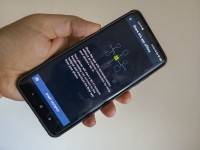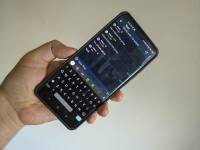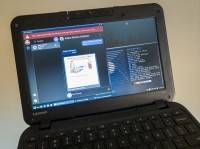How to keep communicating when your internet is disrupted

People love sending electronic messages to each other on their smartphones these days, but in times of conflict and societal struggle, secure, private, & fast communications can save lives. There’s hundreds of electronic messaging apps out there that depend on the internet. Most are designed in a centralized way so that the owning company can be in control of its users (and maybe spy on them or censor them or profit off of them). Things like WhatsApp, iMessage, Signal, Threema, and Telegram are relatively easy to block or take control of since they’re all using centralized servers. Centralized servers are bad for privacy, security, and self agency, too, since you can’t control them yourself and you can’t audit them to see what they’re really doing. They’ve got a good single point of failure for attacking, too. Other federated messaging systems like Matrix, Delta Chat, or email are more open to self-agency and flexible/innovative client/server upgrades that anyone can do. Those are harder to shut down or spy on especially if you’ve customized the clients/servers with various encryption methods. A large web of federated servers helps a lot with sustainability and stability, too. All of that doesn’t really matter at all if you’re in a country where the internet gets turned off completely though. So that’s why we need a totally serverless mesh network like Briar.
But first, electricity
Whether the internet is on or not, you’re still going to need electricity for your phone or other devices. Phone batteries don’t last for weeks and weeks like they used to 20 years ago. One issue with Briar is that since there are no servers running push notifications, it needs to be running in the background all the time. Using TOR connections takes up a lot of battery life as well. If the electrical grid goes down, spots to charge your battery might be hard to find. You might want to invest in a solar charging battery that can be charged by the sunlight. Amazon has plenty of choices for that kind of thing if the shipping channels are still open. You’ll want something with folding solar panels that can absorb more electricity than the smaller ones. For example: Hiluckey Outdoor Portable Power Bank with 4 Solar Panels
Briar
If you have an Android device, you should install this while you still have internet. Briar is a mesh network messaging app that can connect directly with other users over WiFi or Bluetooth. It can also work over the actual internet (using the triple encrypted TOR network) if available, but the key here is that it doesn’t require the internet at all. However, with a direct Bluetooth connection you’re limited in the sense that each node on the mesh network needs to be within range of other nodes. So this is great for more dense populations such as those in Cities or refugees hiding in subway stations or bomb shelters. Again, it doesn’t require any internet connection or cellular phone towers, just WiFi or Bluetooth radios on your devices. That means you can totally communicate underground as long as each person is within range of another person.
Get an Android 4.1+ device that can run Briar.
If you only have an Apple iPhone, you should consider diversifying your tech a bit as Apple basically owns their ecosystem and has extensive control over their devices. Apple could easily limit any of their devices if they decide they don’t like the country you live in or the USA decides they don’t like a country you live in. Bridgefy is an app option that will do something similar to Briar on Apple’s iOS, but it’s closed-source (which means it requires trust), it’s a USA based company, and it’s financed by advertising. It uses centralized servers for sign-up and requires your phone number too, so that’s not good news if you need privacy.
Android is based on an open-source project which makes it easier for you to maintain self-agency over the software (although many manufacturers also try hard to remove your ability for self-agency on Android as well). If you can afford an iPhone, you can also afford a $30 Android phone or tablet as a backup. An iPhone isn’t going to be very useful when the internet goes down anyway. Also see: “Will there be an iOS version of Briar?” I got a couple Alcatel OneTouch IDEAL android phones for $10 each, so it shouldn’t be too difficult to get a cheap Android device for emergency communications. Here are a few other inexpensive choices that you can find on Amazon:
Get the software
Somebody needs to download the app from the Internet before the internet goes down. You can get Briar from F-Droid, Google Play, or a direct APK download. It’s only available on Android and Linux at the moment so you’re going to need a device with one of those operating systems. The desktop Linux version is available in .DEB or .JAR versions or you can compile from source, but it’s still being developed and all of the features of the Android app aren’t yet available on Linux.
After you install the software, it will ask you for a nickname and password. That’s all. The password is just an app password too; it doesn’t go to a server anywhere and there’s no way to recover it (so don’t forget the password you make.) The app doesn’t ask you for any personal information at all; no phone number, no email address, no credit card info… nothing. That’s how you can tell that this is a serious privacy respecting application.
How to use Briar
Use the software to share the installer with offline users

The Briar Android app has built-in WiFi sharing capabilities so that you can send the app’s installation files to other people over WiFi without having internet access. In the settings there’s an item called “Share this app offline”. If you tap that, it will start the instructions. First it will turn your phone into a WiFi hotspot. Give the WiFi hotspot access point name and password to whomever is nearby that wants to install the app. Once they connect, continue the instructions and the next step will be to tell the other people to open their web browser and type in a specific URL. This URL will load the web server on your phone and that web server will display a page to all of your users with a download button. Once they tap the Download button, they will download the APK install file from your phone to their devices. Once the download is finished, they can open the APK and install the Briar app. They may need to change some settings to allow installing apps from the web browser, but that should be an easy thing.
Add each other as contacts
Now that you’ve got Briar installed on some other devices, you need to add each other as contacts. There are two ways to do this. The most secure method is the “add contact nearby” option. In the “Contacts” screen, tap the “+” button at the bottom right and choose “add contact nearby”. This will give you a warning about meeting the person you want to connect to in real life in order to ensure that no one is being impersonated. Tap “Continue” and it will ask to make Bluetooth discoverable and then load a QR code along with a camera viewfinder. You’ll want to be in light mode on Huawei or Xiaomi phones for this to work because their forced dark-mode feature can interfere with the display of the QR code. Use your phone to scan the QR code of your contact and allow your contact to scan the QR code on your phone. This will create a contact pairing that will allow you to communicate on the mesh network. Repeat the “add contact nearby” command for everyone that you want to connect with.
This is a lot more work than adding contacts on other messaging platforms and the reason for that is security. It’s really stupid to use phone numbers as identifiers on messaging apps since phone numbers can be associated with all sorts of other activities. Plus, it’s a bad idea to have too many dependencies that can easily be compromised. Briar’s dependencies are basically… electricity, Android/Linux device, and a Bluetooth radio. It will be very difficult to compromise any of those.

Now that you have contacts, you can send messages! There isn’t anything super crazy about the messaging features in Briar. You can “type message, press send” just like all other messaging apps of the past 40 years. You can also send photos or images and you can insert emoji. No voice messages or video calls or video message filters or silly stickers or goofy 3D animations, but that’s ok… in times of struggle, you’re probably going to become an adult who doesn’t care about that kid’s stuff real quick.
Private messages are only synchronized directly between the sender and receiver, so you’ll need to be within range. The messages will sync to the intended recipients when you are within range over Bluetooth, or if you’re both on the same WiFi network, or if you both have TOR access on the internet.
Another awesome feature in Briar is the ability to “introduce” contacts to other contacts. So for example if I want to enable two of my contacts to be able to message each other privately, I can navigate to one of them, tap the three dots menu in the upper right, choose “Make Introduction”, select another contact to share the first contact with, and then both contacts will get a notification that they can choose to accept in order to enable the new contact connection.
Groups and Forums

You can also create private groups for group messaging or forums for sharing conversations with large numbers of people. With a private group, the person who created the group is the only one who can add more users to it. The creator can also dissolve the group. With forums, anyone can share the forum conversation with anyone else. Unfortunately groups and forums don’t support group-wide image sharing yet.
A forum is probably going to be the best choice to keep a group of offline users in communication. If you introduce all contacts within the forum to each other so that they become contacts for themselves, that will ensure that any members within range can synchronize all of the forum messages.
Blogs

The Blog section is really interesting. You can write blog posts and whomever is connected to you will be able to read it, but there’s also an “RSS Feed” section where you can import an RSS feed from any website and then share that RSS feed with other contacts. So if one person has access to the internet, they can get an updated RSS feed from whatever website filled with news posts and then everyone else on Briar who maybe does not have direct access to the internet will get those RSS feed news posts too. Very clever! If you don’t know what an RSS feed is, RSS stands for really simple syndication and it’s basically an XML file that lists a certain number of the latest news posts or updates on a specific website. Most websites have these available for subscribing to from any RSS reader application.
SneakerNet
That’s right, Briar even supports sharing content via the SneakerNet! What’s the sneakernet you say? That’s when you copy the messages to a disk, take the disk out of the computer, put your sneakers on, run to another computer, and plug the disk into the other computer. You can now copy messages to an external USB disk on one phone, have somebody run to a different phone, plug the disk in, and then load them into another phone or device. Everything is encrypted so that only your intended contact will recieve the content. They’ll also get the updated forums, groups, and blog messages from your device. If you don’t want to have some one run between devices with their sneakers on, you could also probably attach the USB disk to a pigeon trained to fly between locations (FeatherNet).

Synchronizing encrypted messages to a USB or SD disk can also be useful for carrying communications across borders more discreetly than if they were on a smartphone.
The Onion Router (TOR) transfer
As mentioned earlier, if you do have internet access, Briar can use TOR to transfer the messages securely. The Onion Router (TOR) is a network of servers that encrypt internet traffic across multiple nodes. This way each node doesn’t have very much information about the network traffic or where it’s going. If TOR connections are blocked in your country, you can also configure Briar to use bridges to get to TOR. Here’s some more information about how TOR works:
Briar on Linux

There’s also a desktop version of Briar that’s in the works for Linux desktop systems. It’s still in development so all of the features from the Android app are not available yet. Most of the features are not available yet actually, but you can still connect to contacts one to one and share messages or images securely. The Linux desktop app is being made in a way that should make it easy to port to MacOS and Windows in the future, though with the Linux subsystem on Windows you could probably run it as is right now.
Use a WiFi router to increase range
If you have no internet connections on Briar, it can use Bluetooth to transfer messages and pictures as we have shown, but if you can get some WiFi network access points online, that can improve the range of the mesh network. This will be useful even if the WiFi access points don’t have access to the internet as everyone on Briar will be able to transfer messages across a larger range of people. Turning a phone into a WiFi hotspot works as well.
More about how Briar works
Are you a developer?
Briar is open source and being developed by a very small number of people so if you think you can help, be sure to check out the source code and join the development mailing list. They will welcome donations on Liberapay as well.